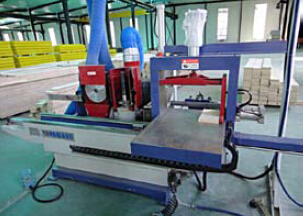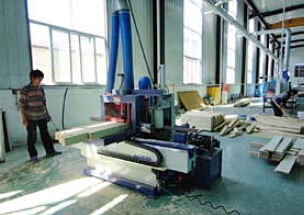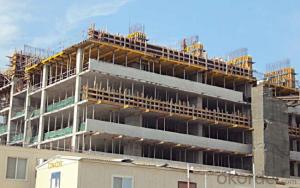Timber-Beam formwork H20 for formwork and scaffolding systems
- Loading Port:
- Tianjin
- Payment Terms:
- TT OR LC
- Min Order Qty:
- 50 m²
- Supply Capability:
- 1000 m²/month
OKorder Service Pledge
Quality Product, Order Online Tracking, Timely Delivery
OKorder Financial Service
Credit Rating, Credit Services, Credit Purchasing
You Might Also Like
Characteristics:
◆ Standardized production lines.
Supply capability: 3000m/day, Lmax = 6600mm.
◆ Finger jointing of the flange and web, the strength of timber beam is highly improved.
Max. shearing force failure load:40KN
◆ Well treated to prevent from water penetration or erosion, so the service life maximally
extended.
Normally, CNBM timber beam H20 can be used for 4 to 5 years, the exact using time would
depend on maintenance & storage.
◆ Robust caps at the end of the girders protect against damages.




- Q:Can steel formwork be used in high-rise construction projects?
- Yes, steel formwork can be used in high-rise construction projects. Steel formwork offers several advantages such as durability, strength, and the ability to withstand high concrete pressure. It provides a stable and efficient solution for constructing walls, slabs, and columns in high-rise buildings. Additionally, steel formwork can be easily customized and reused, making it a cost-effective choice for such projects.
- Q:How does steel formwork affect the overall sound insulation of the structure?
- The overall sound insulation of a structure is not directly influenced by steel formwork. The main purpose of steel formwork is to temporarily support and shape the concrete during construction. It is commonly used for concrete walls, slabs, columns, and beams. The sound insulation of a structure primarily depends on the materials used for walls, floors, and ceilings, as well as the design and construction techniques employed. These factors play a significant role in the transmission of sound waves and the overall acoustic performance of the building. Although steel formwork itself does not possess inherent sound insulation properties, it can indirectly impact the sound insulation of a structure during the construction phase. Improper installation or inadequate securing of the formwork may result in gaps or cracks in the concrete, which can compromise the sound insulation performance of the finished structure. However, it is essential to note that any potential impact on the sound insulation of the structure caused by steel formwork is temporary and can be resolved in subsequent stages of construction. This can be achieved by incorporating suitable acoustic insulation materials or employing soundproofing techniques. In conclusion, steel formwork does not directly affect the overall sound insulation of a structure. The sound insulation of a building is primarily determined by the materials and construction techniques utilized for walls, floors, and ceilings. Proper installation and subsequent measures can address any temporary impact on sound insulation caused by steel formwork during the construction process.
- Q:What are the different types of supports used in steel formwork systems?
- There are several types of supports used in steel formwork systems, including adjustable steel props, scaffolding, bracing systems, and shoring systems. These supports are designed to provide stability and structural integrity to the formwork system during the concrete pouring process.
- Q:What are the different types of steel formwork available?
- There are several types of steel formwork available, including traditional steel formwork, modular steel formwork, and tunnel formwork. Traditional steel formwork consists of steel panels that are assembled on-site and can be used repeatedly. Modular steel formwork is prefabricated and can be easily assembled and disassembled, making it more efficient and cost-effective. Tunnel formwork is specifically designed for the construction of tunnel structures and is made of steel plates that are interconnected to form a continuous wall.
- Q:How does steel formwork handle different concrete surface repair techniques?
- Steel formwork is highly versatile and can easily accommodate various concrete surface repair techniques. Its strong and durable structure allows for the application of techniques such as surface grinding, shot blasting, or sandblasting to remove damaged or deteriorated concrete. Additionally, steel formwork provides a smooth and stable surface, enhancing the effectiveness of techniques like patching, skim coating, or the application of bonding agents. Overall, steel formwork is compatible with a wide range of concrete surface repair techniques, making it a reliable choice for handling such repairs.
- Q:How does steel formwork handle different concrete shrinkage characteristics?
- Steel formwork proves to be a versatile and durable option for concrete construction projects. It effectively manages various concrete shrinkage characteristics. The strength and rigidity of steel formwork are its main advantages. Steel, being a highly robust material, withstands the pressure and forces exerted by shrinking concrete. This ensures the formwork remains intact and stable throughout the curing process, regardless of concrete shrinkage characteristics. Furthermore, steel formwork is easily adjustable and can be modified to suit different concrete shrinkage rates. This flexibility allows contractors to adapt the formwork system to meet specific project needs, effectively addressing any potential shrinkage-related issues. Moreover, steel formwork provides excellent support for concrete during the curing process, minimizing the risk of cracking or deformation caused by shrinkage. The smooth, non-absorbent surface of steel formwork helps prevent excessive moisture loss from the concrete, which can contribute to increased shrinkage. By maintaining a controlled environment, steel formwork regulates the drying process and reduces overall concrete shrinkage. To summarize, steel formwork is a reliable and efficient choice for concrete construction projects. Its strength, adjustability, and ability to provide optimal support and moisture control make it well-suited to handle different concrete shrinkage characteristics. As a result, it ensures the integrity and longevity of the structure.
- Q:How does steel formwork affect the overall labor requirements of a construction project?
- Steel formwork can greatly impact the overall labor requirements of a construction project in several ways. Firstly, steel formwork is highly durable and robust, which means it can be reused multiple times. This reduces the need for labor-intensive tasks such as constantly constructing and dismantling formwork, resulting in significant time and cost savings. Moreover, steel formwork is much quicker to assemble and disassemble compared to traditional timber formwork. This increased efficiency allows construction projects to progress at a faster pace, reducing the overall duration of the project and minimizing labor requirements. Additionally, steel formwork offers greater dimensional accuracy and stability, resulting in fewer adjustments and modifications during the construction process. This reduces the need for labor-intensive rework and ensures that the project stays on schedule. Furthermore, steel formwork can be easily customized and fabricated to meet specific project requirements, which allows for faster and more precise construction. This reduces the need for manual alterations and adjustments, saving both time and labor. Lastly, steel formwork provides a safer working environment for laborers. Its sturdy structure and ability to withstand heavy loads enhance worker safety, reducing the risk of accidents and injuries. This not only ensures the well-being of the workforce but also minimizes potential delays and labor requirements caused by injuries. Overall, steel formwork can significantly reduce the labor requirements of a construction project by streamlining the construction process, enhancing efficiency, improving accuracy, and enhancing worker safety.
- Q:What are the common challenges associated with steel formwork?
- Some common challenges associated with steel formwork include its heavy weight, which can make transportation and installation difficult, as well as its high cost compared to other types of formwork. Additionally, steel formwork requires skilled labor for assembly and disassembly, and it may require additional time for proper cleaning and maintenance to ensure its longevity.
- Q:How does steel formwork contribute to the overall sustainability of a structure?
- Steel formwork contributes to the overall sustainability of a structure in several ways. Firstly, steel is a highly durable material that can withstand extreme weather conditions and resist corrosion. This means that steel formwork can be reused multiple times, reducing the need for new formwork to be manufactured for each construction project. By reducing the demand for new materials, steel formwork helps to conserve natural resources and minimize the environmental impact associated with the extraction and production of new materials. Additionally, steel formwork allows for efficient and precise construction processes. Its strength and rigidity enable it to support heavy loads and provide stability during concrete pouring. This facilitates faster construction time, reducing labor costs and minimizing the use of construction equipment. The efficiency and precision provided by steel formwork contribute to the overall sustainability of a structure by conserving energy and reducing waste. Moreover, steel formwork is a versatile and flexible option that can be easily adjusted or modified to meet changing construction needs. This adaptability allows for the reuse of formwork in different projects, reducing the amount of waste generated. Furthermore, steel formwork can be recycled at the end of its lifespan, contributing to the circular economy by reducing landfill waste and minimizing the environmental impact associated with disposal. Overall, steel formwork promotes sustainability in construction by reducing the need for new materials, conserving energy, minimizing waste, and facilitating efficient construction processes. Its durability, reusability, adaptability, and recyclability make it an environmentally friendly choice that contributes to the long-term sustainability of structures.
- Q:How does steel formwork affect the overall timeline of a construction project?
- Steel formwork can significantly reduce the overall timeline of a construction project. Unlike traditional timber formwork, steel formwork is more durable and can be reused multiple times, resulting in faster assembly and disassembly. Its strength and rigidity allow for faster pouring and curing of concrete, reducing the time required for each construction phase. Additionally, steel formwork requires less maintenance and is less susceptible to warping or shrinking, ensuring a smooth and efficient construction process.
1. Manufacturer Overview |
|
|---|---|
| Location | |
| Year Established | |
| Annual Output Value | |
| Main Markets | |
| Company Certifications | |
2. Manufacturer Certificates |
|
|---|---|
| a) Certification Name | |
| Range | |
| Reference | |
| Validity Period | |
3. Manufacturer Capability |
|
|---|---|
| a)Trade Capacity | |
| Nearest Port | |
| Export Percentage | |
| No.of Employees in Trade Department | |
| Language Spoken: | |
| b)Factory Information | |
| Factory Size: | |
| No. of Production Lines | |
| Contract Manufacturing | |
| Product Price Range | |
Send your message to us
Timber-Beam formwork H20 for formwork and scaffolding systems
- Loading Port:
- Tianjin
- Payment Terms:
- TT OR LC
- Min Order Qty:
- 50 m²
- Supply Capability:
- 1000 m²/month
OKorder Service Pledge
Quality Product, Order Online Tracking, Timely Delivery
OKorder Financial Service
Credit Rating, Credit Services, Credit Purchasing
Similar products
New products
Hot products
Related keywords

























